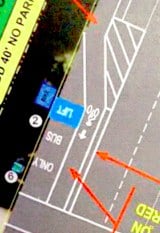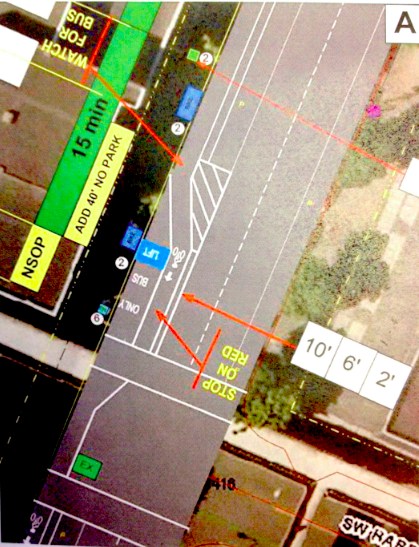
It’s been an issue ever since the protected bike lane (a.k.a. cycle track) on SW Broadway went in: How to improve access for TriMet LIFT Paratransit Program vehicles that need direct access to the curb in order to drop off and pick up people with disabilities, while not blocking the flow of bike traffic.
In its current configuration, the bike lane on SW Broadway near Portland State University is curbside and the auto parking lane is in the street. This was done to create a protective buffer between people on bikes and people in moving auto traffic. The problem is, LIFT vehicles need to extend a ramp so that riders with wheelchairs can roll directly onto the sidewalk.
When the SW Broadway bikeway first opened, vans parked at the curb. Some people on bikes were perturbed by the blockage of the lane, which forced them to either stop and wait, or squeeze between the LIFT vehicles and parked cars. “TriMet has come under criticism by a vocal minority of cyclists for blocking the cycle track,” reads a PSU document about the new plan.
Further complicating the issue is the length of layovers with LIFT vehicles can be quite long since operators often escort their riders door to door.
“This is a small project, but a big step forward in improving things on Broadway.”
— Ian Stude, PSU Transportation Options Manager
Now, thanks to a collaborative effort between PSU staff, the Portland Commission on Disability (PCOD), the City of Portland Bureau of Transportation (PBOT), and TriMet, a solution looks to finally be in the works.
Ian Stude, the transportation options manager at Portland State University, says the school’s Disability Resource Center (housed within the Smith Student Union building) at the corner of SW Broadway and Harrison averages about six pick-ups and drop-offs per day. Ideally, LIFT vehicles would stop right at the curb outside the DRC to service their riders. But since this bike access issue arose, vehicles have avoided the stop and have instead been stopping at SW Mill between 6th and Broadway. That location is several blocks away from the DRC.
“When you factor in that these are people with disabilities,” Stude shared with us, “That’s less than ideal.” He added that due to the nature of LIFT stops (it’s not a set route), people waiting for a ride need to have refuge from the elements and be visible at the stop.
A group of bike advocates and representatives from PCOT, PBOT, TriMet and PSU began meeting about this issue back in June 2010. At that time, some members of PCOD aired serious concerns about how disabled people would be impacted by the growing trend toward curbside, protected bikeways.
At the City’s monthly Bicycle Advisory Committee meeting last week, Stude presented a new plan that has been endorsed by all the stakeholders. Here’s a look at the configuration..

The plan is to extend the current, 20-foot wide no stopping or parking zone (labeled “NSOP” in the drawing above) at SW Harrison another 40 feet. This would create ample space for the LIFT vehicles to park at the curb. The bikeway would then be directed around the LIFT vehicle in a six-foot bike lane with a two-foot buffer from the standard vehicle lane on SW Broadway.
Stude says he’s already gotten approval for this design from the Commission on Disability. “This is a small project,” he said at the BAC meeting last week, “but a big step forward in improving things on Broadway, and it’s another stepping stone toward goodwill between the bicycling and disabled communities.”
The new configuration will be installed for a 3-6 month testing period before the street is permanently restriped.

